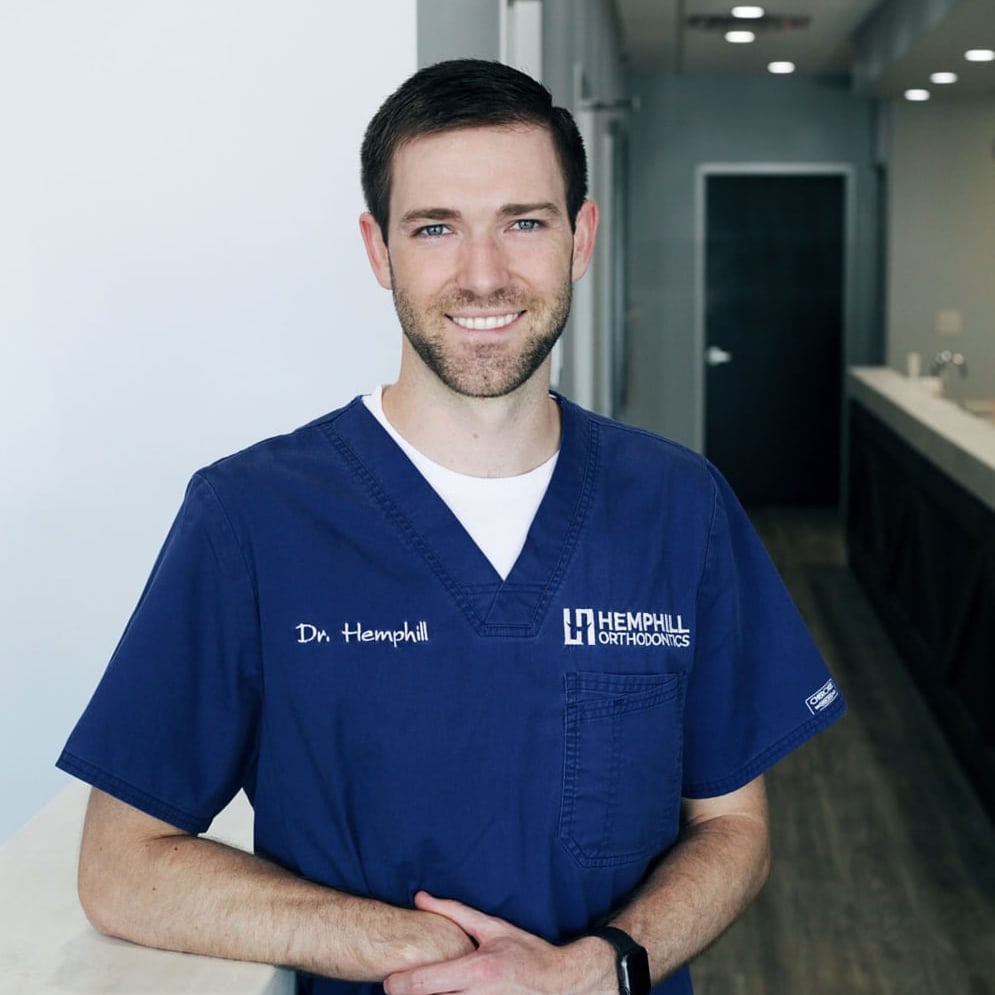Word association is a funny thing. If I say “orthodontics,” what’s the first thing you think of? For most people, it’s the image of a gawky teen wearing a full set of traditional metal braces. This stereotype has a lot of staying power, so it may be surprising to learn that orthodontics can be beneficial to patients of all ages, including younger children. In fact, we recommend (and so does the American Association of Orthodontists) that all kids have their first orthodontic evaluation around the age of 7!
You might wonder why we would want to see them so soon, since children this age usually still have some baby teeth and their mouths are still developing, but it’s all part of the preventative approach we take to orthodontic care here at Hemphill Orthodontics.
When your child has an exam with an experienced orthodontic specialist like Dr. Hemphill at an early age, it gives us the opportunity to catch any existing or potential orthodontic issues sooner rather than later. This reduces the risk of those problems becoming a much bigger deal later on in life, which in turn helps prevent a negative impact on their future permanent teeth and bite.
Because our practice treats a number of younger patients, we’ve been able to observe firsthand how starting treatment at the right time can have a big impact on a child’s overall oral health as well as self-confidence. If your child is ready for their first orthodontic appointment, we’d love to meet you both and take a look at how their mouth is developing! Let’s explore some of the things our team will be checking for during this initial evaluation.
Tooth loss and eruption
Even though our baby teeth eventually fall out, they’re placeholders for the permanent teeth, so where they’re located and when they are lost matters more than you might think. These primary teeth also tend to fall out in a fairly specific order. If we notice any significant deviation from that pattern, it could signify a developmental issue that needs further attention.
At this age, most children will have their first four permanent molars and up to four permanent incisors.If we observe any more or less than this, it could indicate a problem with missing, crowding, or extra teeth. For some of these cases, we may choose to remove a primary tooth early. In others, it may make more sense to simply maintain a space where a tooth has been lost prematurely in order to prevent bigger problems later on.
Crowding and spacing
We will normally be able to tell pretty early on in a child’s life if they’re experiencing problems with excessive crowding or spacing of their teeth, or if these problems seem likely to develop later on. Spacing issues can show up when a tooth is lost prematurely, where one has never developed, or with teeth that are too small or spaced apart. If crowding is the problem, it can often be corrected by expanding the arches or removing certain teeth.

Misalignment
When your teeth are crooked teeth, they’re harder to keep clean. They can also be more susceptible to uneven damage and wear. Misalignment that goes untreated for a long enough period of time can compromise the surrounding gum tissue, affecting the shape and position of it. Even though we’re able to successfully align teeth at almost any age, getting a head start on this can help prevent some of that wear and tear in children. This gives them the best start for a healthy smile that will last a lifetime!
Overbite (protrusive front teeth)
More than just a cosmetic concern, front teeth that obviously protrude are prone to injury, can cause pain in the jaw, and even contribute to certain issues with speech. While we aren’t always able to permanently correct an overbite until your child’s mouth has finished growing, there are still a number of things we can do to help reduce the risk of pain and traumatic injury. We may also be able to improve the overbite in ways that will help a child feel more confident and self-assured.
Underbite
Underbites are generally caused by problems with either the teeth or the jaws. The most difficult scenario involves the lower jaw growing too far forward. In a case like that, we will typically need to wait until the patient has finished growing to begin their treatment. This is usually in their mid- to late-teens. However, early treatment is still important in order to avoid any bite-shifting or damage to the front teeth. Underbite patients who receive early treatment between the ages of about 7-10 are also less likely to need jaw surgery when they get older. An orthodontic specialist like Dr. Hemphill can perform an evaluation to tell you whether your child falls into the category of needing early treatment or not.
Posterior Crossbite
A posterior crossbite can lead to crowding, and may also cause the jaw to shift forward or from one side to the other. Expanding the upper jaw is much easier to perform in earlier childhood rather than the teenage years, and it may allow us to reduce crowding and create space for the front teeth to come through unimpeded. Expansion can also eliminate any shifting that may be present due to a constricted upper jaw. This is important, because jaw shifting caused by posterior crossbites can eventually lead to permanent skeletal asymmetries in the jaws and face.
Anterior Open Bites and Deep Bites
When a child has a bite that is too deep, the top teeth can completely cover the bottom ones when biting. This may indicate an excessively small lower jaw. In an open bite, the upper and lower front teeth do not touch or even overlap when biting down. This is often caused by poor oral habits, such as extended finger or thumb sucking, or using a bottle or pacifier for too long. If this is a problem with your child, our team will be happy to work with your child to eliminate any destructive habits early on, correct any resulting problems that have occurred already, and allow further development to continue normally.

Early evaluations are part of improving oral health at Hemphill Orthodontics
Reading through these issues, it’s easy to see why early orthodontic evaluations can be an important part of your child’s overall oral health! Timing is a factor, since the jaw bones continue to harden as children get older, and eventually stop growing. If orthodontic procedures are needed after that point, they will often involve longer treatment times and may require more invasive procedures, like tooth extractions or oral surgery.
Having your young child examined by an experienced orthodontist like Dr. Hemphill can often help prevent the need for orthodontics as an adult, and make comprehensive orthodontic treatment faster and more efficient!
Here at Hemphill Orthodontics, we’re committed to providing quality orthodontic care for patients of all ages in a friendly, stress-free environment. Your child’s smile will always be our top priority! If you’re ready to schedule your child’s first orthodontic appointment, get in touch with us today to get started with a FREE consultation!
 972-636-4175
Free Consult
972-636-4175
Free Consult

 Dr. Hemphill
Dr. Hemphill